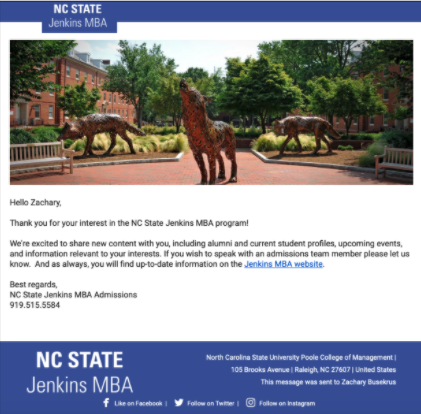A few weekends ago, I got a little bit bored and decided to embark on an Enrollify secret shopper experiment (I had binged Tiger King in two days and swore off Netflix for the rest of the week...so, I had some time on my hands).
I was curious about how colleges and universities were adjusting their communication flows in light of COVID-19 — especially graduate programs.
More broadly speaking, I was interested in discovering which schools were “killing it” from a prospective student engagement standpoint and which were struggling.
So, I went ahead and set up a fake, but real-enough, email address and completed requests for MBA programs at 80 different business schools.
Like most people would, I started my experiment by Googling “best business schools” and clicked on the first organic result, which, as you may have suspected, was U.S. News and World Report.
I figured that the top 20 MBA programs could probably survive on brand alone (and therefore didn’t need to worry as much about the quality of their communication flows), so I excluded the Ivy’s, the Cals, the Virginias, etc., from this experiment.
We’re gearing up to publish the results from this experiment soon, but here are some teaser stats for you:
- Only 25% of schools said anything about COVID-19 in the first email of their comm flow
- 22% of email subject lines were simply "thank you" or "thank you for requesting information" without additional context.
- Only 5.8% of emails received contained personalization in either the subject line OR the email preview text.
In short, most automated communications from business schools suck (pardon my French, but I stand by this adjective)...and this presents a huge opportunity for schools/programs looking to differentiate themselves from the rest of the pack.
Many middle-of-the-road MBA programs are more or less the same from a curriculum standpoint...come on, you know it’s true.
As such, business programs need to think creatively about other ways to stand out — and I believe delivering an exceptional prospective student experience is one of the easiest and most effective ways to do just that.
Here are three ideas for how enrollment marketers can deliver better prospective student experiences via their email communication flows.
Create Compelling Confirmation Emails — No One Else is Doing This Well
Confirmation emails receive an 80% open rate — that’s the highest open rate you’re going to see on any email type. And most of them look something like this:
Hi Zach, we’ve received your request for information! One of our admissions counselors will be in touch with you soon. If you want to start your application, you can do so here.
-- The University of Boring Communications
First off, I wish I had some meaningful data on what the app-start rate from RMI-confirmation communications really is.
Do people REALLY start an application right after requesting more information about a program? Do enrollment marketers think that prospects missed the flashing yellow “Apply” CTAs all over their site?
Anyhow, here’s the opportunity:
80% of people who fill out a form on your website will open the trigger they receive post-conversion — therefore, you should spend more time crafting the subject line, preview text, creative, and copy in this email than you do on any other.
Refuse the temptation to copy and paste the language on your landing page into your thank you email.
Be better than the 3-bullet point “this is why our program is the best thing since sliced bread” summary.
Obsess over your subject line and preview text like faculty do over their website program pages.
Your goal with this email should be to extract additional context about the inquiry — her preferred method of content consumption, where she’s at in her journey to enrollment, what she’s most excited about and what she’s most worried about — by delivering additional value.
Here are some ideas on how to do just that:
- Invite them to read a student testimonial on your blog that is relevant to their program of interest
- Send them a 2-3 minute recap video of your last program information session webinar
- Record and share a Loom or Drift video with them outlining how to find and navigate the content most relevant to their interests.
- Offer educational content at the awareness (an ebook on “If, When, and Where to Go to Grad School”), consideration (“The ROI of a Master’s in Public Health”), and decision stages (A Guide to Financing Graduate School) of the enrollment journey.
Don’t just thank them for inquiring...offer them 3-5 additional things to do/take action on that will equip your enrollment team with deeper insight into the goals and pain points of the prospective student.
More Personalization Should = A Better Experience (How to Use Data Well)
In the aforementioned secret shopper experiment, a startling 60% of post-inquiry emails used only one personalization token in their communications — <First Name>.
Look, if you ask me for my name, my phone number, my program of interest, and my start term of interest in order to complete my inquiry, I expect you to use this context in your communications with me. And frankly, personalization should go both ways.
Too many post-inquiry communication flows are from corporate identities like “the institution” or “the admissions team.” I think you can make the case for corporate identities being used as the from name/from email address for automated email communications, but certainly not the first email in your 7-email drip sequence.
At the very least, Email #1 of every drip sequence should include something like the following:
Hi <First Name>,
I am looking forward to connecting with you to hear your story and learn about your career goals. It’s my understanding that you’re interested in learning more about our <Program Name> and considering the pursuit of a graduate degree in <Term of Interest>. I’d like to schedule a time for a brief conversation to determine how our team can best serve you at this stage in your journey to grad school. Feel free to snag a time on my calendar that is convenient for you and I’ll call you at <Phone Number>, or send me a couple of days/times that work to chat next week.
Sincerely,
<Program Coordinator><Program Coordinator Email><Cell Phone>
But this is really just scratching the surface. We’ll soon be living in a world where inquiry forms are a thing of the past. Users will interact with chatbots to get their basic questions answered and then “book meetings” with program coordinators when they’re ready to have a more serious conversation.
Furthermore, tracking an individual user’s digital behavior and content preferences, and adapting communications in accordance with these behaviors in realtime, will become standard.
Advanced enrollment marketers will know which inquiries prefer information delivered via video and which prefer information via text message.
All this is to say that the expectations for a highly personalized email experience will only grow — and the schools that put in the work now won’t be scrambling to catch up later.
Here’s what the future of drip sequence email #1 will look like:
At the very least, Email #1 of every drip sequence should include something like the following:
Hi <First Name>,
Thanks for booking time on my calendar! I am looking forward to our <Type of Chat...Video/Phone Call/Live Text Session> with you on <Date of Meeting> to hear your story and learn about your career goals.
I thought I’d share a couple of student stories and alumni outcome reports with you before our chat.
<Preferred Content-Format for Student Stories...Video, Blog Post, Podcast>
<Preferred Content-Format for Alumni Outcome Reports = Animated Video or PDF Report >
If you have any immediate questions that our <Name of Chatbot> wasn’t able to answer for you, you can…
- Watch our Loom Video FAQs at <Loom Video Library>
- Send me a Video SMS with your question at <Video SMS Inbox>
- Connect and message with me on LinkedIn at <LinkedIn Profile>
- Text me at <Phone Number>
Sincerely,
<Program Coordinator><Program Coordinator Email><Cell Phone>
To summarize: if you’re going to collect user data, use it to deliver a personalized, frictionless experience. The schools that really double down and truly personalize the email experience will win.
Design Really, Really, Really (Like Really) Matters — And Schools Stink At It
Have you ever received an email from Sweetgreen or Allbirds? The copy, the creative, the personalization, the offers, are nothing short of beautiful.
Sweetgreen is trying to sell me a $10 salad…
Allbirds is trying to sell me a $100 pair of shoes...
Most business schools are trying to sell me a $50,000+ MBA.
Why is it that so many communication flow emails look like they use the same Constant Contact email template from 5 years ago?
Why does higher education think that they can pay less attention to the design of an email than a shoe company does?
What enrollment marketers often forget when drafting communications is that you’re not just competing against other schools...you’re competing against every other email in a prospect’s inbox! You’re after eyeball time.
More eyeball time = more focused time = an increase in the likelihood that a user will take that next step in his/her journey to enrollment.
When it comes to email, front porch copy (my term for the real estate email subject lines and preview text offer) will always trump design in importance — design doesn’t matter if the subject line and preview text don’t convince the user to open the email.
But that doesn’t mean design doesn’t matter — in fact, when it comes to email click-through-rates I’d argue that design matters more than email body copy (Neil Patel agrees).
90% of drip emails from business schools look like this:

So, the opportunity is obvious here — design better emails.
To sum up this soapbox monologue, email marketing is widely important. It’s still the most influential channel in the enrollment journey. For the enrollment managers and higher ed marketing and communications folks struggling to stand out from the crowd, focus on delivering an exceptional email marketing experience.
Choose to be radically different in your tone and content offers in your automated, trigger-based communications.
Commit to leveraging the data points you have on prospects to deliver genuinely personalized experiences.
Decide to invest in design.
If you don’t, it’s just a matter of time before someone else does.






Submit a Comment